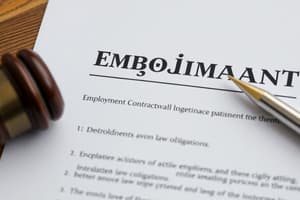Podcast
Questions and Answers
In the context of firms, which statement best describes the relationship between owners, managers, and employees?
In the context of firms, which statement best describes the relationship between owners, managers, and employees?
- Employees and managers always prioritize the owners’ interests above their own.
- Owners, managers, and employees invariably agree with each other.
- They are united by a common interest in the firm's success but may have conflicting interests regarding the distribution of profits, policies, and decision-making. (correct)
- They share identical interests in all aspects of the firm's operations and profit distribution.
According to Herbert Simon's perspective, what would a visitor from Mars primarily observe when looking at Earth's economic structure?
According to Herbert Simon's perspective, what would a visitor from Mars primarily observe when looking at Earth's economic structure?
- A network of red lines connecting green spots, representing market exchanges between consumers.
- A chaotic mix of colors, making it impossible to discern any clear economic structure.
- Large green areas interconnected by red lines, with green areas representing firms and red lines symbolizing market transactions. (correct)
- A complex web of blue lines representing authority within families.
How does the coordination of labor within firms differ from coordination through markets?
How does the coordination of labor within firms differ from coordination through markets?
- Firms feature decentralized power where employees make largely autonomous decisions, unlike markets.
- Both firms and markets rely on the autonomous decisions of individuals.
- Firms represent a concentration of economic power controlled by owners and managers, while markets are characterized by decentralized autonomous decisions. (correct)
- Both firms and markets rely on government regulation.
Which statement accurately describes the nature of labor contracts, according to the content?
Which statement accurately describes the nature of labor contracts, according to the content?
What potential conflict arises from the separation of ownership and control in a firm?
What potential conflict arises from the separation of ownership and control in a firm?
What is the 'residual claimant' in a firm, and how does this status affect their incentives?
What is the 'residual claimant' in a firm, and how does this status affect their incentives?
Why is the employment contract considered 'incomplete'?
Why is the employment contract considered 'incomplete'?
What is the role of 'employment rent' in the employer-employee relationship?
What is the role of 'employment rent' in the employer-employee relationship?
According to the analysis of employment rents, which of the following scenarios would likely result in a higher level of work effort from an employee?
According to the analysis of employment rents, which of the following scenarios would likely result in a higher level of work effort from an employee?
What is the 'labor discipline model' designed to explain?
What is the 'labor discipline model' designed to explain?
Flashcards
Division of labour
Division of labour
The specialization of producers to carry out different tasks in the production process.
Firms
Firms
Economic organizations where owners hire labor for goods/services production to make profit.
Asymmetric information
Asymmetric information
Information relevant to parties in an interaction, known by some but not all.
Contract
Contract
Signup and view all the flashcards
Wage labour
Wage labour
Signup and view all the flashcards
Residual claimant
Residual claimant
Signup and view all the flashcards
Share
Share
Signup and view all the flashcards
Separation of ownership and control
Separation of ownership and control
Signup and view all the flashcards
Free ride
Free ride
Signup and view all the flashcards
Employment relationship
Employment relationship
Signup and view all the flashcards
Study Notes
- Firms serve as both actors in the capitalist economy and stages for interactions among employees, managers, and owners.
- Working together in firms yields mutual benefits, but employing workers differs from procuring other goods/services.
- Employment contracts frequently omit details, leading to potential conflicts due to differing interests of employer and employee.
- Firms strategically set wages to motivate employees, deter turnover, and ensure a pool of applicants.
- This practice results in persistent unemployment, even in equilibrium.
- Alternative work arrangements exist in the gig economy and worker-owned cooperatives.
- The Firestone tire recall in 2000 led to a stock market value drop of $9.2 billion due to faulty tires from the Decatur, Illinois plant.
- Labor strife, including pay cuts and changes in work shifts, is suspected to have led to employee retaliation affecting tire quality.
- Firms are economic actors but are also composed of individuals with shared and conflicting interests.
- Employees, Managers & Owners commonly seek the firm’s success, but may conflict over profit distribution and policies.
- Focus is given to the firm as a stage to model the relationships among employees, managers, and owners to show how wages are determined when there are conflicts of interest.
- Division of labor is the specialization of producers to carry out different tasks in the production process.
- Firms are economic organizations in which private owners of capital goods hire and direct labor to produce goods and services for sale on markets to make a profit
Firms, Markets, and Labor Division
- The division of labor is coordinated through firms and markets.
- Firms produce components internally and assemble them, while markets facilitate interactions between firms.
- Herbert Simon viewed firms as "green fields" connected by "red lines" of buying and selling, contrasting with the traditional focus on markets.
- Focus needs to be on instititions and goverments due to uncertainty and rapid change. These alternative ‘authority mechanisms’ draw on partially understood aspects of the human psyche: loyalty, group identification, and creative satisfaction.
- The firm is Composed of individuals, whose needs and desires might conflict: In what ways could these differences be resolved? When would an individual shift from contract work (a ‘sale’ of a particular, predefined task) to an employment relation? An employment relation where a boss dictates the task after the sale is the relationship at the heart of a firm.
Coordination of Work
- Labor coordination within firms differs from market coordination.
- Firms centralize economic power in owners and managers, issuing commands.
- Markets decentralize power, with autonomous decisions driving purchases and sales.
- Authority structures and market interactions characterize the modern capitalist firm.
- Firms have decision-making processes to impose decisions.
- Owners decide long-term strategies through the board of directors then direct the manager(s) to implement these decisions.
- Asymmetric information creates challenges between hierarchical levels, influencing command execution.
- Firms have decision-making processes to impose decisions.
- The relationship dynamics between firms and customers are different. Firms offer incentives, instead of requirements unlike employment relationships.
- A firm differs because it is defined by having a decision-making structure in which some people have power over others.
Power Relations
- Karl Marx emphasized inherent employer-worker conflict.
- Employers rent workers' labor and command them inside the firm, leading to power imbalances.
- An open market has transactions between equals—nobody is in a position to order anyone else to buy or sell.
- Coase agreed with Marx on authority's central role in firms; however, disagreenments occurred about if hierarchy of the firm was cost reducing or limited the employees freedom.
Contracts and Relationships
- Contracts are legal documents or understanding that specifies a set of actions that parties to the contract must undertake.
- Market interactions and firm relationships differ in contracts.
- Sales contracts transfer ownership, while rental contracts grant limited rights.
- Wage labor contracts give employers authority over employees' time and activities on the job.
- Employment relationships have a limited set of right over the apartment including the right to exclude others.
- Contracts can be written or an understanding between the employer and the employee.
Separation of Ownership and Control
- There are two aspects of ownership of a firm:
- The owners direct the activities of other participants in the firm
- The owners receive the firm’s profits
- Profit is the residual claimed by the owners.
- A part of the assets of a firm that may be traded is a share of the firm, giving the holder a right to receive profit and to benefit when the firm’s assets become more valuable.
- Separation of Ownership and Control: The attribute of some firms by which managers are a separate group from the owners.
- Potential Conflict of Interest: Managers' decisions affect profits, impacting owners' incomes, leading to potential conflicts. Managers may prioritize personal gain over shareholders' interests.
- Aligning Interests: Owners incentivize managers through performance-based contracts and board oversight. Shareholders can instigate revolts to influence management, though difficulties in collaboration exist.
- Despite separation, firms modeled as profit maximizers due to owner incentives and market competition pressure. This market competition eliminates firms that do not make substantial profits for their ouwners.
Employment Relationship
- Most people work in firms, with employers controlling wages and working conditions.
- Employees can quit or decide on effort levels, influencing employer outcomes.
- Employment relationships have the employer setting the hours and other conditions of work and the wage, directs the employee’s activities and may terminate her employment, and the employee chooses how hard to work and whether to quit her job. The employee’s level of effort, or her decision to remain in the firm, are determined by the choices made by the two parties—and are affected by the exercise of power by the employer and the social norms of both parties.
- For an employer and an employee to remain in the employment relationship, both need to gain something compared to the next best alternative.
- Owners want more employee effort at a lower wage, while workers want a higher wage for less effort, creating conflict of interest.
Paying Workers
-
Piece rates pay a fixed amount for each unit of output vs an hourly/daily wage; however, are impractical in modern economies due to the measurement of employees output.
-
Gig economies use piece rates for individual tasks like with the delivery and transport services.
-
Incomplete employment contracts are due to:
- The employer cannot see the future -It is expensive, and may be impossible, to measure effort -The contract may not be enforceable
-
Incomplete Contract: A contract that does not specify, in an enforceable way, every aspect of the exchange that affects the interests of parties to the exchange (or of any others affected by the exchange).
Doing A Good Day's Work
- People put in a good day’s work because:
- It is its own reward
- Feelings of responsibility for other employees or for one’s employer may provide strong work motivation
- Firms use performance-related pay to reward hard work.
- Fear of being fired, or of missing the opportunity to be promoted into a position that has higher pay and greater job security
- Unemployment Benefit: A government transfer received by an unemployed person. Also known as: unemployment insurance.
- The employer can set the wage so as to get a good day’s work from the employee.
- Utility: A numerical indicator of the value that one places on an outcome, such that higher-valued outcomes will be chosen over lower-valued ones when both are feasible.
- Disutility of Effort: The degree to which doing some task (effort) is unpleasant.
Employment Rents
-
Taking the employee’s perspective of how hard to work, the employer looks at daily costs and benefits of having and losing a job, and would like to find a way to make the worker love having her job, at least compared to the alternative.
-
Many of the items in columns A and B of the figure are beyond the control of the employer. But one is not.
-
Employment Rent: The economic rent a worker receives when the net value of her job exceeds the net value of her next best alternative (that is, being unemployed). Also known as: cost of job loss.
-
To decide how much it is worth to her to keep the job at the wage offered in the employment contract, the worker has to think ahead: ‘How hard will I have to work, what is the chance of being sacked or not promoted for slacking on the job, and what are my prospects if I lose my job? It takes time to get another job and during that time, an unemployed worker relies on unemployment benefits and may lose other job-related benefits like a sense of making a productive contribution or health insurance. Also, if I lose my job now, the next job I find may pay less.’
-
Reservation Wage: What an employee would get in alternative employment, or from an unemployment benefit or other support, were he or she not employed in his or her current job.
-
Natural Experiment: An empirical study exploiting naturally occurring statistical controls in which researchers do not have the ability to assign participants to treatment and control groups, as is the case in conventional experiments.
Work Effort and Wages
- Labour Discipline Model: A model that explains how employers set wages so that employees receive an economic rent (called employment rent), which provides workers an incentive to work hard in order to avoid job termination. Also known as: employment rent, efficiency wages.
- Game: A model of strategic interaction that describes the players, the feasible strategies, the information that the players have, and their payoffs.
Studying That Suits You
Use AI to generate personalized quizzes and flashcards to suit your learning preferences.




